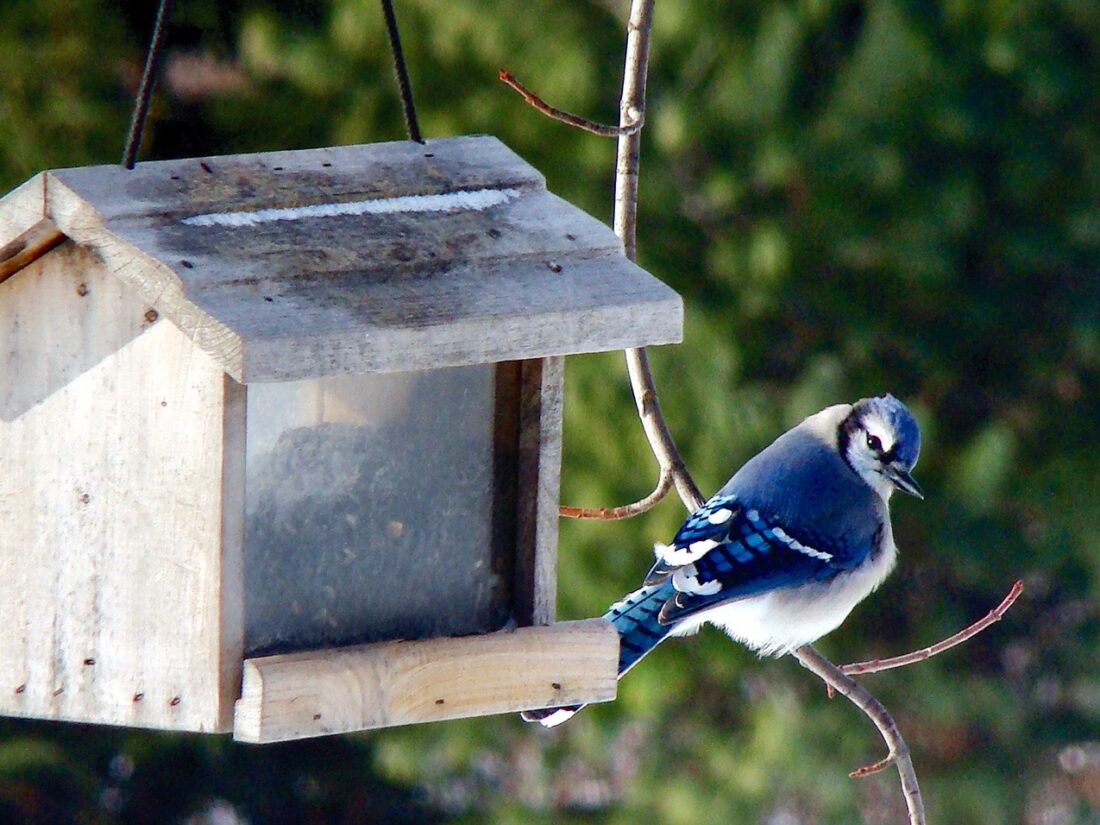If you love watching birds visit your yard, you might wonder how to make your feeders more inviting. One simple trick can make a big difference: where and how far apart you place your feeders.
Getting this right helps you attract more birds and enjoy their colorful visits without scaring them away. You’ll discover the perfect spacing that keeps your feathered friends comfortable and coming back for more. Keep reading to turn your backyard into a lively bird paradise!

Credit: www.mariettatimes.com
Choosing Feeder Locations
Placing bird feeders in the right spots can attract more birds to your yard. It is important to choose locations that suit different bird species and keep them safe.
This guide helps you decide how far apart feeders should be and where to place them for the best results.
Considering Bird Species
Different birds have different feeding habits and territorial needs. Some birds prefer feeders close together, while others need more space.
- Small birds like chickadees often feed near each other and accept close feeders.
- Larger birds, such as cardinals, need more space between feeders to avoid conflicts.
- Territorial birds like woodpeckers may require feeders placed far apart to reduce fighting.
Assessing Yard Size
The size of your yard limits how many feeders you can place and how far apart they should be.
| Yard Size | Recommended Feeder Distance | Number of Feeders |
| Small (under 500 sq ft) | 5-7 feet apart | 1-2 |
| Medium (500-1500 sq ft) | 7-10 feet apart | 2-4 |
| Large (over 1500 sq ft) | 10-15 feet apart | 4 or more |
Avoiding Predator Zones
Keep feeders away from areas where predators hide or can easily reach birds.
- Place feeders at least 10 feet from dense shrubs where cats hide.
- Keep feeders 5 feet away from jump points like fences or walls.
- Use poles with baffles to prevent climbing predators.
Spacing Guidelines For Feeders
Placing bird feeders correctly helps attract more birds to your yard. Proper spacing reduces fights and keeps birds safe.
Different birds and feeder types need different distances between feeders. This guide explains how far apart to place feeders.
Minimum Distance Rules
Feeders should be spaced to give birds enough room to feed without feeling crowded. Too close feeders cause stress and fights.
A good rule is to keep feeders at least 3 to 5 feet apart. This distance helps reduce aggressive behavior among birds.
- Space feeders 3-5 feet apart
- Keep feeders away from windows to prevent collisions
- Place feeders near shrubs or trees for quick cover
Spacing For Different Feeder Types
Each feeder type attracts different birds and needs different spacing. Tube feeders can be closer than platform feeders.
Platform feeders need more space because many birds feed there at once. Hummingbird feeders need to be farther apart to avoid fights.
| Feeder Type | Recommended Spacing | Reason |
|---|---|---|
| Tube Feeders | 3 feet apart | Small birds feed quietly |
| Platform Feeders | 5 feet apart | More space for many birds |
| Hummingbird Feeders | 10 feet apart | Territorial birds need space |
Adjusting Distance For Bird Behavior
Watch how birds use your feeders. If you see fights, increase the space between feeders. Some birds are more territorial.
Also, move feeders if one spot gets too crowded. Changing placement helps shy birds feel safe and visit more often.
- Increase spacing if birds fight
- Move feeders to less busy spots
- Add more feeders to reduce competition
Benefits Of Proper Feeder Placement
Placing bird feeders at the right distance helps attract more birds. It also keeps the birds safe and happy.
Good feeder placement makes it easier for birds to eat. It supports different bird species visiting your feeders.
Reducing Bird Conflicts
Birds can be territorial and fight over food. Spacing feeders far apart lowers these conflicts.
When feeders are too close, dominant birds may chase others away. Proper spacing gives shy birds a chance to feed.
- Place feeders at least 10 feet apart
- Separate feeders of the same type to avoid crowding
- Use different heights for feeders to reduce competition
Encouraging Diverse Bird Visits
Different birds prefer different types of feeders and food. Spreading feeders helps attract a wider variety of birds.
Proper spacing allows many species to visit without stress. It also helps you enjoy watching many kinds of birds.
- Place seed feeders separately from nectar feeders
- Use feeders at different heights for ground and tree birds
- Space feeders to reduce food competition among species
Improving Feeding Efficiency
Birds feed better when they do not feel crowded. Proper feeder spacing helps birds eat calmly and quickly.
With enough space, feeders stay cleaner longer. This lowers disease risk and keeps food fresh.
- Keep feeders 10 to 15 feet apart to reduce crowding
- Place feeders near cover for bird safety
- Clean feeders regularly to keep birds healthy
Common Placement Mistakes
Placing bird feeders correctly helps attract many birds to your yard. Wrong placement can scare birds away or cause accidents. Learning common mistakes can improve your bird feeding experience.
Below are key placement errors to avoid for safer and more effective bird feeding.
Overcrowding Feeders
Putting feeders too close causes competition and stress among birds. Overcrowding also spreads diseases quickly. Birds need space to feed comfortably and safely.
- Space feeders at least 10 to 12 feet apart.
- Use multiple feeders to reduce crowding.
- Keep feeders at different heights for variety.
- Clean feeders regularly to prevent illness.
Placing Feeders Too Close To Windows
Feeders near windows cause birds to fly into glass. This results in serious injury or death. Birds do not see glass as a barrier.
| Safe Distance | Reason |
| At least 3 feet away | Reduces collision risk |
| Or within 30 inches | Birds can slow down before hitting |
| Use window decals | Makes glass visible to birds |
Ignoring Shelter Needs
Birds need shelter near feeders to feel safe. Lack of cover exposes them to predators and bad weather. Proper shelter encourages more birds to visit your feeders.
Tips for providing shelter near feeders:
- Place feeders near shrubs or trees.
- Use brush piles or evergreen plants.
- Avoid open areas with no hiding spots.
- Keep some distance so birds can spot danger early.
Seasonal Adjustments For Feeder Setup
Bird feeding changes with the seasons. Adjusting feeder placement helps attract more birds year-round.
Seasonal changes in weather and bird behavior affect how far apart feeders should be placed.
Winter Spacing Tips
In winter, birds need energy and safety. Place feeders closer to shelter like bushes or trees.
Feeders should be spaced about 10 to 15 feet apart. This reduces fighting over food.
- Keep feeders near cover to protect birds from cold and predators
- Space feeders 10 to 15 feet apart to avoid crowding
- Use multiple feeders to support more birds during harsh weather
Summer Feeder Placement
Summer brings more insects and natural food. Birds visit feeders less often but still need water.
Space feeders farther apart, around 15 to 20 feet. This reduces competition and keeps birds calm.
- Place feeders in shaded areas to keep food fresh
- Space feeders 15 to 20 feet apart to reduce stress
- Offer water sources near feeders for hydration
Adapting To Migration Patterns
During migration, bird numbers increase. Feeders should be spaced to welcome many visitors.
Place feeders 10 to 15 feet apart to allow easy access. Provide varied food types for different species.
- Use multiple feeders spaced 10 to 15 feet apart
- Offer mixed seeds to attract various birds
- Keep feeders clean to prevent disease during migration

Credit: dengarden.com
Additional Tips For Attracting Birds
Placing feeders at the right distance helps birds feel safe. There are other ways to attract more birds to your yard. Using different foods, keeping feeders clean, and adding water can make a big difference.
These tips help create a welcoming place for many bird species. Birds will visit often and stay longer with the right setup.
Using Diverse Food Types
Offer a variety of seeds and foods to attract different birds. Some birds like sunflower seeds, while others prefer suet or fruit. Mixing food types brings many species to your feeders.
Change the food seasonally to match bird needs. In winter, high-fat foods help birds stay warm. In spring, fresh fruits and nectar attract hummingbirds and orioles.
- Black oil sunflower seeds attract many songbirds
- Nyjer seed is good for finches
- Suet attracts woodpeckers and nuthatches
- Fruit pieces bring orioles and tanagers
- Nectar feeds hummingbirds during warmer months
Maintaining Clean Feeders
Clean feeders regularly to keep birds healthy. Dirty feeders can spread diseases. Use warm water and mild soap to wash feeders every two weeks.
Check for mold or spoiled food and remove it quickly. Dry feeders well before refilling. Clean feeder areas on the ground to avoid pests.
- Wash feeders in warm, soapy water
- Rinse thoroughly to remove soap
- Dry feeders completely before refilling
- Remove moldy or old food immediately
- Keep the ground under feeders clean
Incorporating Water Sources
Birds need water for drinking and bathing. Adding a water source attracts more birds to your yard. A birdbath or small pond can work well.
Keep the water fresh and clean. Change it often, especially in hot weather. Moving water, like a small fountain, can attract more birds.
- Use shallow birdbaths with gentle slopes
- Change water every two days
- Keep water free of algae and dirt
- Add a dripper or fountain for movement
- Place water near feeders but with some cover

Credit: dengarden.com
Frequently Asked Questions
How Far Apart Should Bird Feeders Be Placed?
Bird feeders should be placed 10 to 15 feet apart. This spacing reduces territorial disputes and allows multiple bird species to feed comfortably. It also minimizes aggressive behavior and helps attract a variety of birds to your garden or backyard.
Why Space Feeders To Attract More Birds?
Spacing feeders properly prevents overcrowding and competition among birds. It creates a safe environment, encouraging shy or smaller birds to visit. Proper spacing increases the diversity of species and ensures all birds have access to food without stress.
Can Close Feeders Cause Bird Fights?
Yes, placing feeders too close often leads to aggressive bird behavior. Birds may fight over limited space, scaring away others. Keeping feeders apart reduces conflicts and promotes peaceful feeding, benefiting all bird visitors.
Does Feeder Spacing Affect Bird Species Variety?
Yes, wider feeder spacing attracts a greater variety of bird species. Different birds prefer different feeding zones. Proper spacing allows both dominant and timid birds to coexist, increasing species diversity at your feeders.
Conclusion
Placing bird feeders correctly attracts more birds to your garden. Keep them spaced, ensuring a safe and friendly environment. Birds enjoy variety, so mix different types of feeders. Regularly clean feeders to keep birds healthy. Observe bird behavior to adjust spacing if needed.
With patience, you’ll see more birds visiting. Enjoy watching them thrive in your space. Birdwatching brings joy and connects you with nature. Remember, every garden is unique. Experiment to find the best setup for your space. Happy birdwatching!

